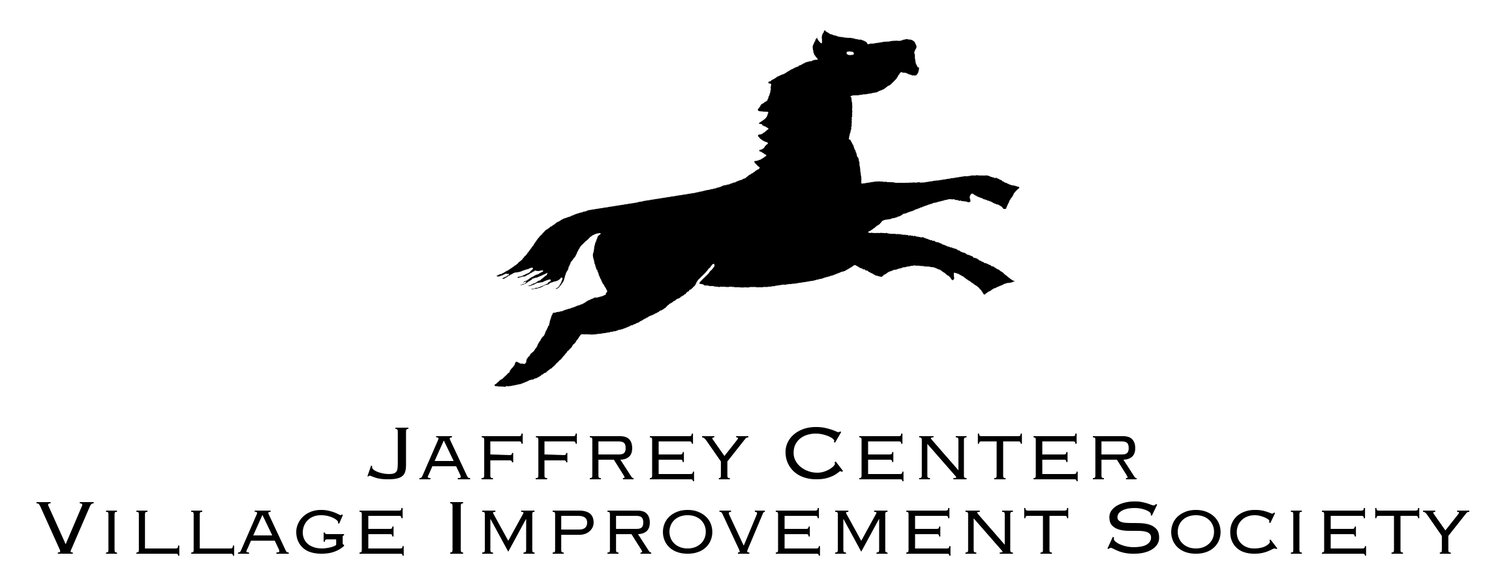The VIS: A Historical Perspective
Centennial Park with views of Mount Monadnock.
The Jaffrey Center Village Improvement Society was organized in 1906 by ten civic-minded residents, nine women and one man, in response to the deteriorating appearance of their Jaffrey Center neighborhood. Rob Stephenson writes in his Marshal the Willing Forces, A Centennial History of the Jaffrey Center Village Improvement Society, published in 2006, that on Monday, August 27th, 1906, “Ten persons met in the dining room of the Fox house on Academy Street, now [17] Thorndike Pond Road,” to discuss the need for a Village Improvement Society and to think about how to organize a Society.
A group of women in 1936. Back: Mary Phelps, Mabelle Cutter, Middle: Georgia Bigelow, Mrs. John Poole, Front: Carrie Fernald, Kate Fox.
The ten Jaffrey residents, ages 35–57, were: Mary and Kate Fox, Georgia Bigelow, Anna Haven, Mabelle Cutter, Alice Livingston, and Mary Phelps; Mrs. B. L. Robinson was the lone married woman. The Rev. Frederick W. Greene was the lone man. Silas Buck was elected in absentia as the first President, but he died after two years in office, and Mrs. Benjamin Robinson was appointed to succeed him. Margaret Robinson presided as President from 1908 until 1928 when Mrs. Lawrence Wetherell succeeded her. Josephine Wetherell was President from 1928 until 1948. These two women created the foundation for the civic-minded attention to the community that has continued for over a century. Since 1948, there have been 22 Presidents of the VIS, often referred to as The Society.
The ten Jaffrey Center residents were inspired to organize a Village Improvement Society by the national Village Improvement Society Movement which was started in 1853 by Mary Hopkins Goodrich in Stockbridge, MA. Known as The Laurel Hill Association, this is the oldest VIS in the country still in existance. The stated purpose of the Laurel Hill Association “was and remains to do ‘such things as shall serve to improve the quality of life and of the environment in the town of Stockbridge.’
Flowers at horse trough, one of the first actions the JCVIS made to decorate the streets of Jaffrey Center
Photograph by Suze Campbell
”Rob Stephenson, in Marshal the Willing Forces, writes that its founder, Mary Hopkins Goodrich, was “Stockbridge’s version of Mrs. Robinson and Mrs. Wetherell rolled into one.” He writes that soon after 1853, “Books and articles appeared extolling the virtues and benefits of village improvement and giving instruction on how to organize improvement efforts. Susan Fenimore Cooper, daughter of James Fenimore Cooper, wrote on village improvement societies in the September 1869 issue of Putnam’s Magazine: a “permanent, voluntary society of respectable character, composed of influential persons” should act “as a general stimulant to torpid corporations and to unmanageable individuals.” She laid out guidance for organizing an improvement society, covering such topics as streets and sidewalks, weeds, yards, parks, cemeteries, and protection of birds.
In the September, 1876 issue of Scribner’ s Monthly, Josiah Holland added the “planting of trees to the important work of village improvement societies,” noting how many societies had developed in the years since their beginning two decades earlier. He also suggested that competitions between villages would benefit the accomplishments of each individually. Holland, writes Stephenson, “recognized that women were key to all of” the VIS movement.
Orange day lillies through the granite and post fence draw the eye to Centennial Park’s hillside flag pole and VIS bench.
Photograph by Ken Campbell
Another chronicler of the VIS movement, Parris T. Farwell, in an article in the Farmer’s Almanac entitled Village Improvement, concluded that the “village improvement society is simply a means for enabling the people of a community to create and perpetuate this kind of village, one that makes this kind of impression.”
Following the village improvement society movement, nationally recognized historic districts were instituted. The first U.S. historic district, established in Charleston, South Carolina in 1931, predated the U.S. federal government designation of historic districts and buildings by more than three decades. In 1966, the federal government created the National Register of Historic Places, shortly after a report from the U.S. Conference of Mayors had stated Americans suffered from "rootlessness."
In 1969, The Jaffrey Town Meeting established the Jaffrey Historic District Commission and, in 1970, it designated our neighborhood as the Jaffrey Center Historic District. In 1975, the Historic District was placed on the National Register of Historic Places. In 2006, the JCVIS celebrated its 100th Anniversary. 2020 is the 100th Anniversary of Melville Academy Museum.
Map of Jaffrey Center by J.D. Gibbs, 1850.














